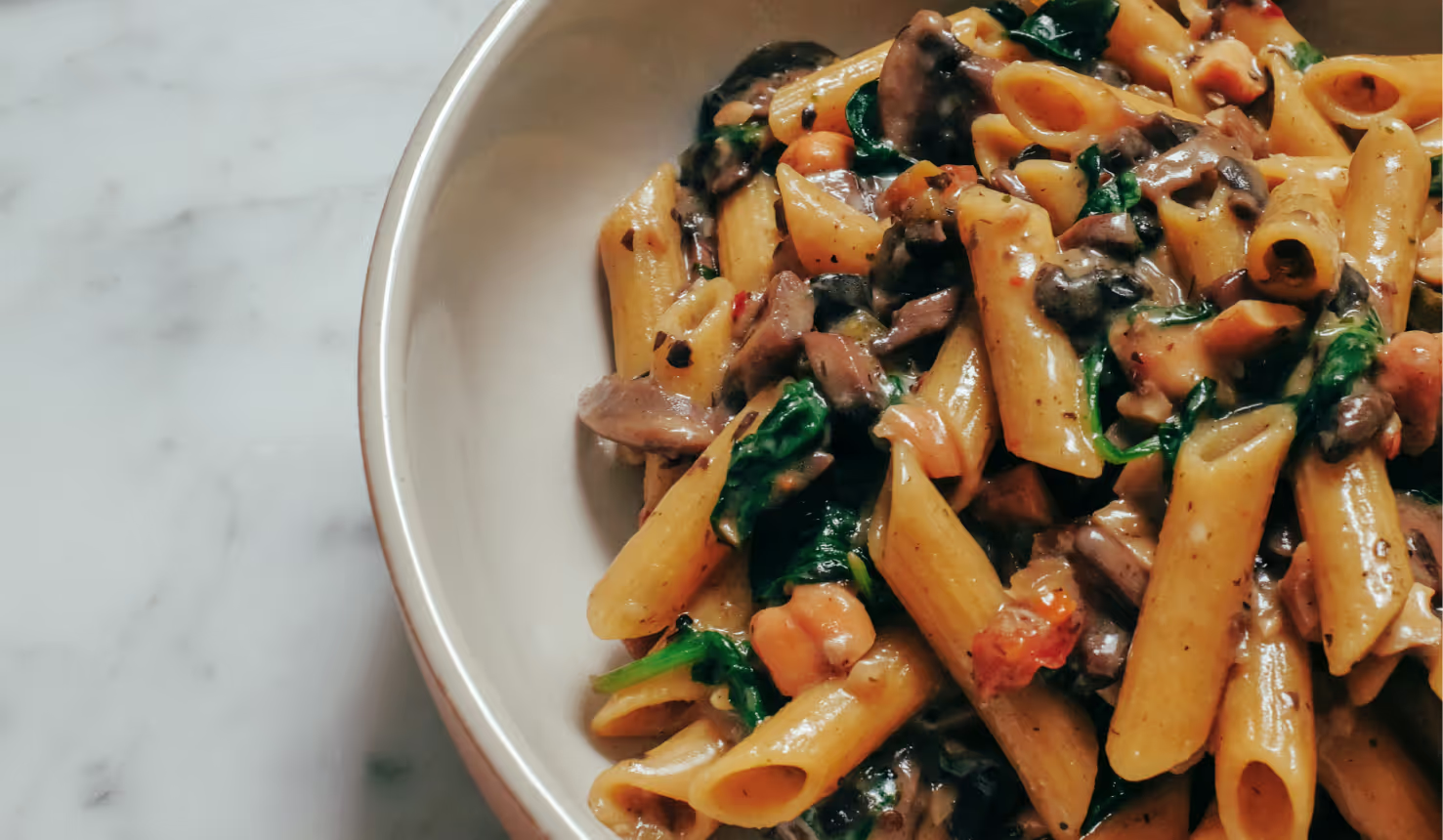A Beginner's Guide to Plant-Based Diets

Join the community





Whether you're doing it for the health of your body, the planet, or animals, there are many reasons to start eating a more plant-based diet. For many of us though, it’s not easy to quit meat cold turkey. Use this guide to prep your pantry and get the motivation and inspiration you need to start eating more plant-based meals.
What are the benefits of a plant-based diet?
Plant-forward eating doesn’t necessarily mean you choose not to eat animal products at all. Rather, it means you eat more food from plants (like fruits, vegetables, grains, legumes, nuts, and oils) and eat less food from animal-based sources (like meat, poultry, fish, and dairy).
A plant-based diet can take many forms. As described by Harvard Medical School, plant-based diets include:
- Semi-vegetarian or flexitarian: eats eggs, dairy foods, and occasionally meat, poultry, fish, and seafood.
- Pescatarian: eats eggs, dairy foods, fish, and seafood, but no meat or poultry.
- Vegetarian (aka lacto-ovo vegetarian): eats eggs and dairy foods, but no meat, poultry, fish, or seafood.
- Vegan: eats no animal foods (no meat, poultry, fish, seafood, eggs, or dairy)
Eating Plant-Based for the Your Health
Eating more plants comes with plenty of health benefits. Plant-based dies are rich in fiber, which aids in digestion, helps maintain a healthy weight, and lowers the risk of chronic diseases such as heart disease, diabetes, and certain types of cancer.
They’re typically lower in saturated fats and cholesterol, contributing to improved cardiovascular health. Additionally, plant-based diets are abundant in vitamins, minerals, and antioxidants which boost the immune system and promote overall well-being. They are also associated with reduced inflammation and lower blood pressure. These advantages make a plant-based diet an excellent choice for those seeking to enhance their health and longevity.
Eating Plant-Based for the Planet
Eating more plants instead of animal products results in lower emissions. In fact, eating less meat is one of the most impactful ways most of us can lower our carbon footprint.
If we all were to cut consumption of meat and animal products by 50%, we’d reduce global greenhouse gas emissions by 7.5%. An average American who lowers their footprint by 7.5% is having an impact equal to that of 68 trees in a year.
That single action gets us one-tenth of the way to achieving the Paris Climate Targets and capping global warming at 1.5C by 2030.

If you’re gradually stepping into a more plant-based diet, the quickest way to reduce your carbon footprint is by cutting down on red meats like beef, lamb, and pork. Per gram of protein, the emissions of livestock production are notably higher than the emissions of white meat like fish and chicken.

The perks for the planet aren’t only in emissions. Eating more plants gives you more opportunity to eat with the seasons. Each season offers the opportunity to try different produce. For fall, gorgeous, ripe, end-of-summer tomatoes. Berries are happiest in the spring, brightening up salads or a morning breakfast. Root vegetables are the highlight of winter soups and stews. And greens like kale, chard, lettuce, and mustard greens are fresh, year-long sources of crunch and nutrition.
How to get started with a plant-based diet
1. Stock up on essentials in your pantry and fridge
Successfully sticking with plant-based eating is all about prep. First, before you toss all your animal products in the trash, consider giving it to a friend or neighbor, or donating it to a community fridge. When we prevent food waste, we drastically cut down on landfill emissions.
If you’re only cutting down on meat, you’ll need to stock up on other proteins. If you’re trying to cut out all animal products (including eggs and dairy), we have some suggestions for those too.
- Swap out your proteins: Stock up on some protein-packed, plant-based tofu, chickpeas, lentils, and nuts. There are also plenty of meat substitutes like Beyond Meat, Impossible Foods, and Nuggs.
- Swap out your milks: If you’re looking to switch to non-dairy milk, try oat for the lowest emission choice. There are plenty of others to explore too.
- Swap out your butter: If you’re going vegan, you’ll need to explore alternatives for butter. Try high-heat oils like safflower or canola for sauteeing. If you’re looking for a butter alternative for baking, use this guide.
- Swap out cheese: There are a lot of milk-free cheeses out there. Check out this list to start your search.
- Swap out eggs: This may be the hardest one to replicate, but if you’re looking for an egg substitute to use as a binder in a baking recipe (or something similar) there are plenty of worthy options.
2. Stock up on snacks and treats
It’s easy to forget to prepare for the smaller treats that get you through the day. A little forward thinking can help avoid a late afternoon snack of salami and cheese. Here are a few of our favorite treats:
- Fresh fruit: Berries in the spring, stone fruits in the summer, apples in the fall, and citrus, like grapefruit or oranges, in the winter. All are delicious, sweet, and packed with vitamins.
- Nuts and nut butters: Keep a couple bottles of peanut, almond, or cashew butter, or even tahini (made from sesame) on hand for a quick, protein-filled snack. Perfect to smear on bread, crackers, or apples for a treat any time of the day.
- Hummus: Hummus is another protein-packed pantry staple for herbivores. Pair it with vegetables like cucumbers, peppers, or carrots, or with pita or pita chips.
- Guacamole and salsa: Much of Mexican cooking is naturally vegan. If you have an avocado, onion, and lime on hand, you can make a mean guac (add tomato or pomegranate for a sweet bite, and cilantro and green chili for spice). With just a few tomatoes, onion, and chili, you can also make a fresh delicious salsa.
- Sorbet or vegan ice cream: Fruit sorbet is a perfect vegan treat. There is also a variety of vegan ice cream in grocery stores, like Ben and Jerry’s non-dairy ice cream.
3. Plan your meals
There are so many incredible dishes from around the world rooted in plant-forward cultures. Pick a few meals you (and your family or friends) can get excited about, and plan your grocery shopping around them. With the following groceries, you can whip up several plant-based meals from around the world:
- Chinese and Thai-inspired recipes. Tofu, rice, noodles, eggplant, broccoli, greens, garlic, ginger, soy sauce, peanut butter, sesame oil, red chili
- Indian-inspired cooking. Lentils, brown beans, rice, cauliflower, eggplant, potato, garlic, ginger, cumin, coriander, turmeric, green chili
- Italian-inspired cooking. Plant-based meats or fish, white beans, pasta, arborio rice, eggplant, greens, garlic, red chili, basil
- Mexican-inspired cooking. Tofu, black beans, tortillas, peppers, squash, tomato, avocado, garlic, cumin, red chili
4. Get inspiration (6 Plant-Based Instagram Chefs)
Like any habit change, eating more plant-based meals can require some encouragement and inspiration. Add some great vegan chefs to your feed to get new ideas:













